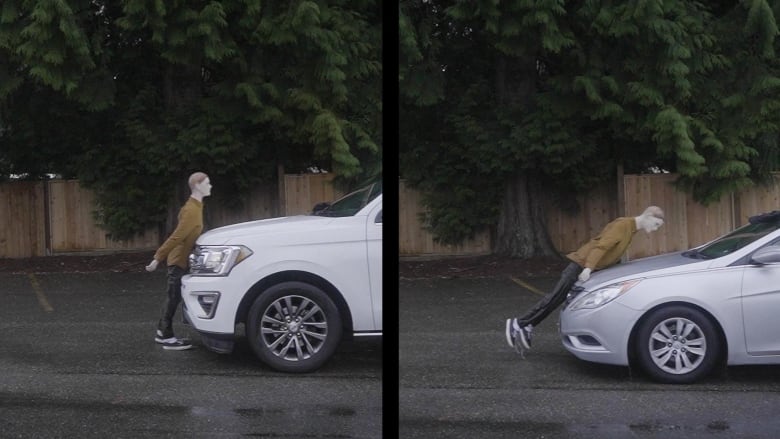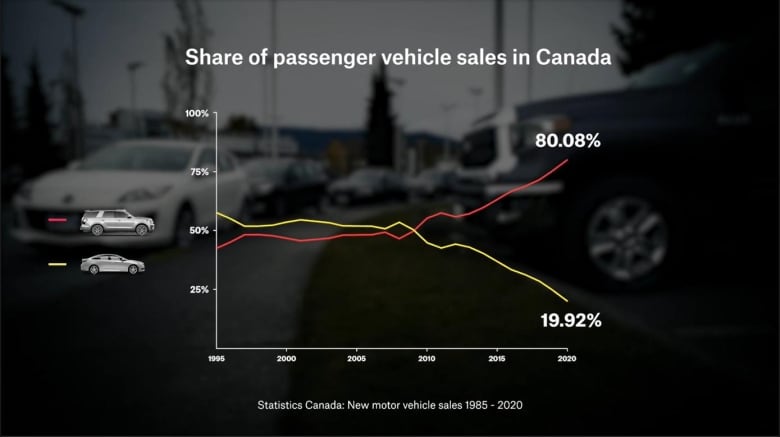SUVs protect drivers, but make everyone else less safe. How do we change that?
'A bigger, heavier vehicle provides better crash protection than a smaller, lighter one,' study finds

This story is part of Uytae Lee's Stories About Here, an original series with the CBC Creator Network. You can watch every episode of this series on CBC Gem.
An SUV is two to threetimes more likely to kill a pedestrian in a collision compared to a regular car, according to a 2015 reportfrom the U.S. National Highway Traffic Safety Administration.
Why?
It's a design problem.
A key feature of an SUV is that it sits higher off the ground compared to other types of cars. That means if ithits a pedestrian, its bumper is colliding with the person's rib cage and vital organs.
But more importantly, the vehicle isdirectly hitting a person's centre of gravity, which meansit is more likely to push the pedestrian forwardsand run them over.
Compare that to a sedan: with its lower height, it is more likely to clip a pedestrian's legs and send them flying on top of its hood, which is designed to be bouncy like a metal trampoline. Still very painful, but not as likely to be fatal.
That difference isconcerning because SUVs are becoming very popular. In 2020, the light truck segment of cars, which includes SUVs, pickups and vans, accounted for 80per cent of new car sales in Canada, according to Statistics Canada a share that's been growing for the last decade.
At the same time, sedan sales have fallen off a cliff, accountingfor just barely 20 per centof new vehicles sold in 2020.
Increase in pedestrian deaths
Meanwhile, pedestrian deaths are increasing.
According to a recent study by the Organisation for Economic Co-operation and Development, Canada reported a 5.6 per centincrease in pedestrian deaths between 2010 and 2018, while deaths among cyclists, drivers and motorcyclists all saw decreases.
But this trend is really apparent when you look at data coming from the United States. Pedestrian deaths there had been decreasing since the 1980s, but in the last decade they've been sharply rising again, according to numbers from the Governors Highway Safety Association, which monitors traffic safety.

And according to the United States' National Highway Traffic Safety Administration, while SUVs account for only about a third of pedestrian collisions, they are responsible for closer to 40 per centoffatalities.
Still, people buy SUVs for a reason. Ironically, one of the biggest reasons is safety.
A vehicular 'arms race'
In a study of vehicle deaths between 2015 to 2018, sedans registered 48 deaths per million owners every year. That number for SUVs was nearly half, at 25 deaths per million owners.
The bigger the vehicle, the less likely the risk of death for its passengers. This can be seen for other large vehicles, like minivans and pickup trucks.
By that same token, smaller cars were more likely to be deadlier cars. The deadliest car in thestudy was the Ford Fiesta, a mini-sedan which registered 141 deaths per million owners every year.
The Insurance Institute for Highway Safety, whichwrote the study, puts it plainly:"A bigger, heavier vehicle provides better crash protection than a smaller, lighter one, assuming no other differences."
The SUV is a bigger car, makingit a safer car. So drivers buy bigger cars, which are more dangerous to smaller cars, leading to what economistMichelle Wright called an "arms race" of vehicle sales.
So how do we make our roads safer, not just for people inbig SUVs, but for everyone?
Find out in Stories About Here: The Problem with SUVs.
About this series

Stories About Hereis an original series with the CBC Creator Network that explores the urban planning challenges that communities across Canada face today. In each episode we dig into the often overlooked issues in our own backyards whether it's the shortage of public bathrooms, sewage leaking into the water, or the bureaucratic roots of the housing crisis. Through it all, we hope to inspire people to become better informed and engaged members of their communities.
You can watch every episode of this seriesonCBC Gem.












_(720p).jpg)


 OFFICIAL HD MUSIC VIDEO.jpg)
.jpg)



























































































